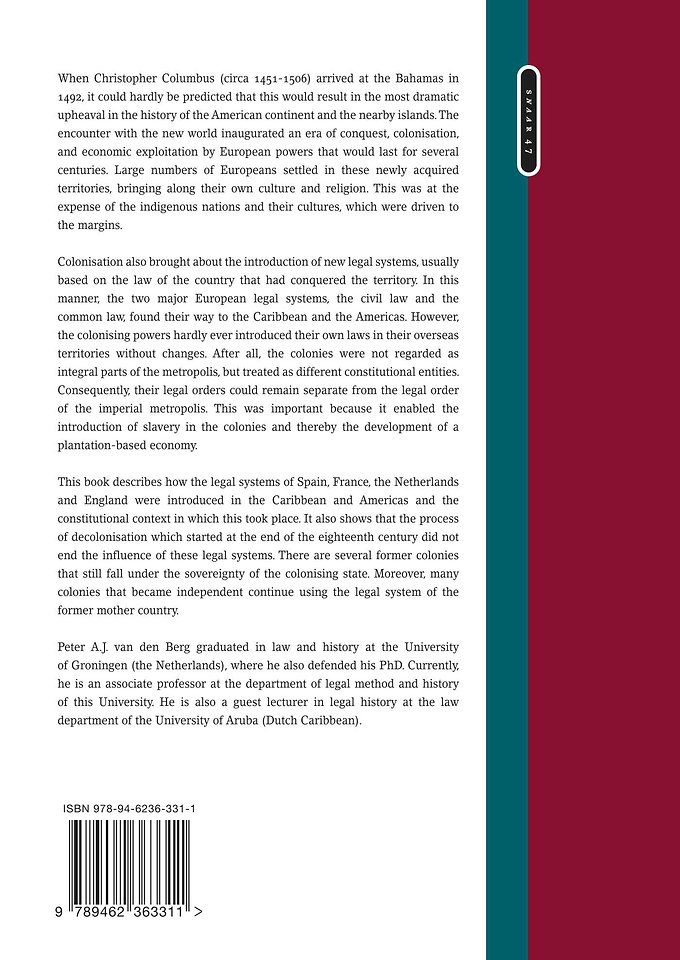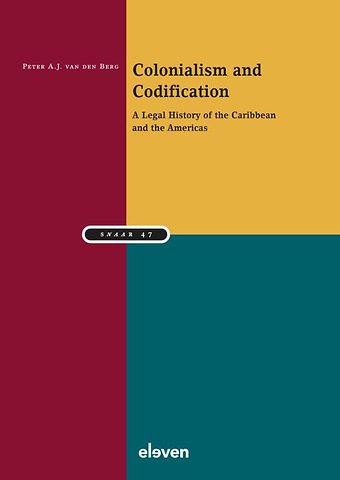



Peter A.J. van den Berg is universitair hoofddocent aan de juridische faculteit van de Rijksuniversiteit Groningen.
Meer over Peter van den BergColonialism and Codification
A Legal History of the Caribbean and the Americas
Samenvatting
When Christopher Columbus (circa 1451-1506) arrived at the Bahamas in 1492, it could hardly be predicted that this would result in the most dramatic upheaval in the history of the American continent and the nearby islands. The encounter with the new world inaugurated an era of conquest, colonisation, and economic exploitation by European powers that would last for several centuries. Large numbers of Europeans settled in these newly acquired territories, bringing along their own culture and religion. This was at the expense of the indigenous nations and their cultures, which were driven to the margins.
Colonisation also brought about the introduction of new legal systems, usually based on the law of the country that had conquered the territory. In this manner, the two major European legal systems, the civil law and the common law, found their way to the Caribbean and the Americas. However, the colonising powers hardly ever introduced their own laws in their overseas territories without changes. After all, the colonies were not regarded as integral parts of the metropolis, but treated as different constitutional entities. Consequently, their legal orders could remain separate from the legal order of the imperial metropolis. This was important because it enabled the introduction of slavery in the colonies and thereby the development of a plantation-based economy.
This book describes how the legal systems of Spain, France, the Netherlands and England were introduced in the Caribbean and Americas and the constitutional context in which this took place. It also shows that the process of decolonisation which started at the end of the eighteenth century did not end the influence of these legal systems. There are several former colonies that still fall under the sovereignty of the colonising state. Moreover, many colonies that became independent continue using the legal system of the former mother country.
Trefwoorden
Specificaties
Inhoudsopgave
1 The Pre-Columbian era 17
1.1 Discovery, conquest and colonisation 17
1.2 Codification and Native American law 19
1.2.1 The chthonic legal tradition 19
1.2.2 The Incas and the Aztecs 21
1.2.2.1 Incas 21
1.2.2.2 Aztecs 23
1.2.3 Native American law after the conquest 24
2 The Spanish overseas territories in the West 27
2.1 Conquest and consolidation of a global empire (1492-1800) 27
2.1.1 Political developments 27
2.1.2 The Spanish claim to the American and Caribbean territories: legal basis and reality 29
2.1.3 The constitutional and governmental structure of the overseas territories 33
2.1.4 Doctrine of sources of law and codification in the overseas territories 39
2.2 Developments after 1800: an empire in decline 46
2.2.1 Political developments 46
2.2.2 Constitutional developments and the codification movement until 1823 50
2.2.3 Constitutional developments and the codification movement after 1823: Cuba and Puerto Rico 55
2.3 The new states of Central and South America 61
2.3.1 Political developments 61
2.3.2 Constitutional developments and the codification movement 63
2.3.2.1 Common features 63
2.3.2.2 Mexico, Costa Rica, Guatemala, Nicaragua, El Salvador and Honduras 68
2.3.2.3 Bolivia, Argentina, Paraguay and Uruguay 77
2.3.2.4 Chile and Peru 84
2.3.2.5 Colombia, Venezuela, Panama and Ecuador 88
2.3.2.6 Dominican Republic 96
3 The French overseas territories in the West 99
3.1 The establishment of a colonial empire (1600-1789) 99
3.1.1 Political developments 99
3.1.2 The constitutional and administrative structure of the overseas territories 102
3.1.3 Doctrine of sources of law and the codification movement 108
3.2 The colonies from the French Revolution until the Second World War (1789-1940) 117
3.2.1 Political developments 117
3.2.2 Constitutional developments and the codification movement 120
3.2.2.1 The revolutionary era (1789-1799) 120
3.2.2.2 The Napoleonic period (1799-1814): the introduction of the Code civil 145
3.2.2.3 The monarchy restored (1815-1848) 151
3.2.2.4 Developments after 1848 155
3.3 Codification in an era of decolonisation (1940-2015) 164
3.3.1 Political developments: occupation, liberation and decolonisation 164
3.3.2 Constitutional structure and the position of the Code civil 170
3.3.2.1 The DOMs 170
3.3.2.2 The TOMs/COMs 172
3.4 Saint-Domingue (Haiti) after independence (1804) 174
4 The Dutch overseas territories in the West 179
4.1 The Republic of the Seven United Netherlands and the overseas territories (1625-1795) 179
4.1.1 Political developments 179
4.1.2 The constitutional and administrative structure of the overseas territories 182
4.1.3 Doctrine of sources of law and codification 189
4.2 The overseas territories from the Batavian Revolution to the Second World War (1795-1940) 197
4.2.1 Political developments 197
4.2.2 Constitutional developments and the pursuit of codification 198
4.2.2.1 The Batavian-French period (1795-1813) 198
4.2.2.2 The Kingdom of the Netherlands until the Second World War (1813-1940) 217
4.3 Codification in an era of decolonisation 255
4.3.1 Political developments since 1940 255
4.3.2 Constitutional developments and (re)codification 259
4.3.2.1 Developments up to 2010 259
4.3.2.2 Developments since 2010: the dismantling of the Netherlands Antilles 269
5 British overseas territories in the Caribbean and the Americas 273
5.1 The establishment of a colonial empire (1600-1776) 273
5.1.1 Political developments 273
5.1.2 The constitutional and administrative structure of the overseas territories 276
5.1.2.1 The development of autonomous colonies 276
5.1.2.2 Attempts to reduce the autonomy of the colonies 281
5.1.3 Doctrine of sources of law and the codification movement 288
5.1.3.1 The development of autonomous colonial legal orders 291
5.1.3.2 Increasing influence of the English common law 298
5.2 From adversity in the West to the establishment of a world empire (1776-1918) 302
5.2.1 Political developments 302
5.2.2 Constitutional and administrative developments 303
5.2.3 Law, sources of law and codification 308
5.2.3.1 Separate legal orders: slaves, free people of colour, indentured labourers and Native Americans 308
5.2.3.2 Codification movement 312
5.3 Dismantling a world empire 327
5.3.1 Political developments after 1918 327
5.3.2 Constitutional developments and the codification movement 330
5.3.2.1 Constitutional developments 330
5.3.2.2 The law and the codification movement 333
5.4 The United States after independence (1783) 340
5.4.1 Political developments 340
5.4.2 Constitutional developments and the codification movement 341
5.4.2.1 The American Constitution (1787) and the general prospects for codification 341
5.4.2.2 Codification in Louisiana 343
5.4.2.3 Codification in some common law states 352
6 Colonialism and codification: a comparative overview 363
6.1 Colonialism and codification during the Ancien Régime 363
6.2 The French Revolution and its consequences for the codification movement 365
6.2.1 The colonial powers in the civil law tradition: France, the Netherlands and Spain 365
6.2.2 Colonialism, common law and codification: Great Britain 369
Bibliography 373
Index 401
Serielijst SNAAR | Previously published in SNAAR 411
Anderen die dit boek kochten, kochten ook
Rubrieken
- cadeauboeken
- computer en informatica
- economie
- filosofie
- flora en fauna
- geneeskunde
- geschiedenis
- gezondheid
- jeugd
- juridisch
- koken en eten
- kunst en cultuur
- literatuur en romans
- mens en maatschappij
- naslagwerken
- non-fictie informatief/professioneel
- paramedisch
- psychologie
- reizen
- religie
- schoolboeken
- spiritualiteit
- sport, hobby, lifestyle
- thrillers en spanning
- wetenschap en techniek
- woordenboeken en taal





